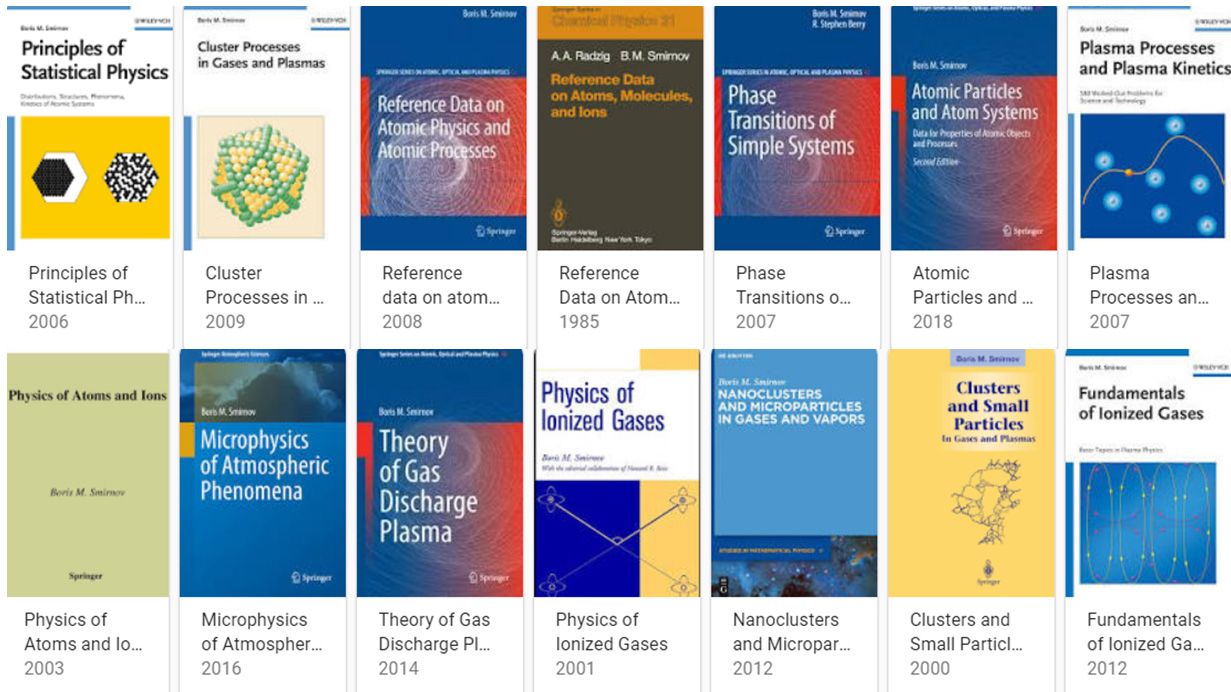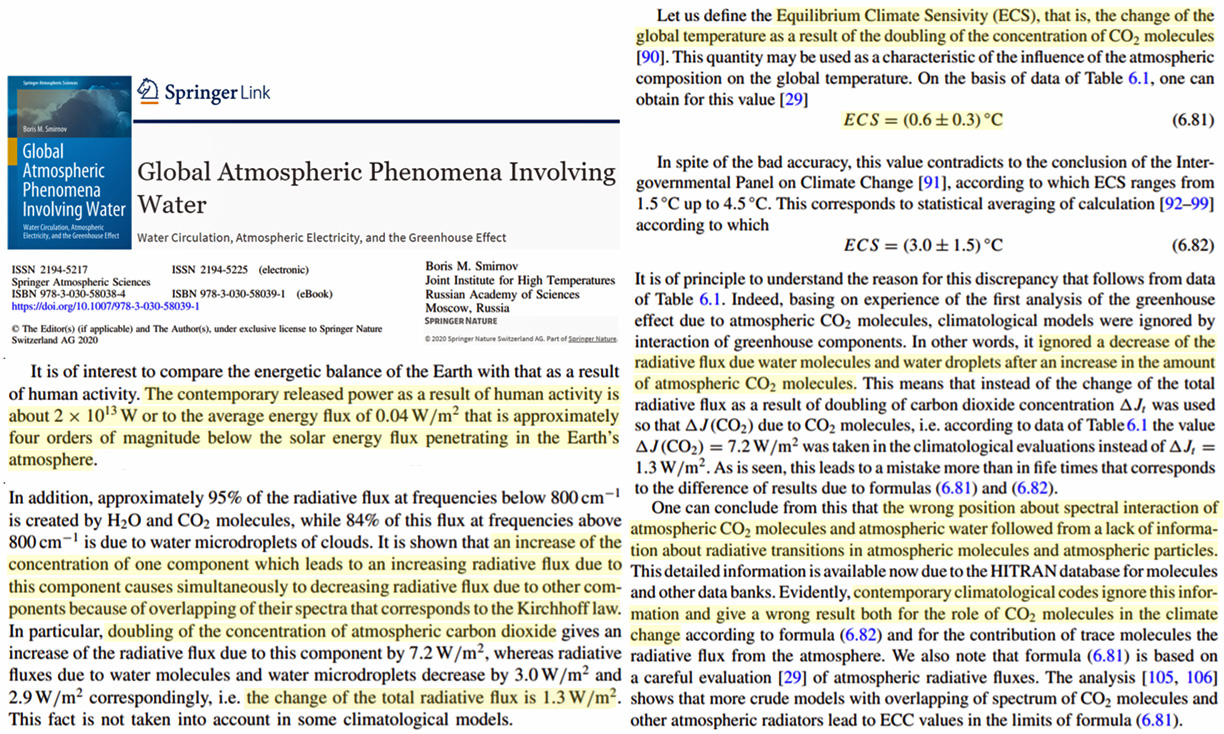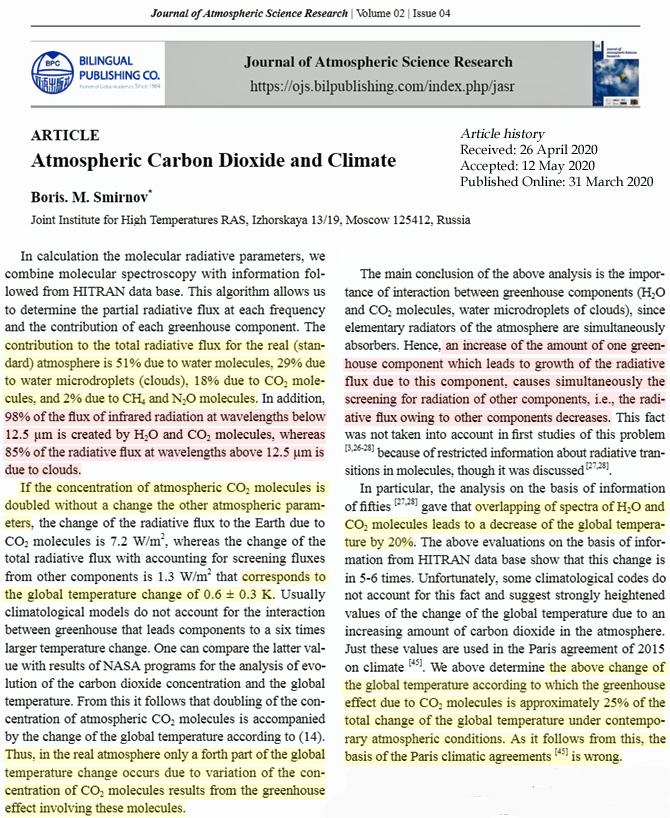Several more estimates of extremely low CO2 climate sensitivity have been added to the database in the last year.
The collection of scientific papers that assess a very low (under 1°C for a doubling of CO2) or a non-quantified, but negligible climate sensitivity has swelled to over 130. In 2015, when it was first published, there were only 50 papers on the list.
Here is the link to the database: 130+ Extremely Low CO2 Climate Sensitivity Papers
Over the years Dr. Boris Smirnov, physicist, has published nearly two dozen books on molecular, atomic, and gas physics.

Image Source: Amazon
In 2020, Smirnov contributed both a scientific paper and Springer book on the physics of climate to the list. In both publications he concludes the equilibrium climate sensitivity (ECS) for a doubling of CO2 (280 to 560 ppm) is just 0.6°C.
Interestingly, he assesses the water molecules and droplets (gas and clouds) – 85% of the infrared radiation flux – serve to reduce rather than enhance the total net forcing from CO2 with feedbacks (1.3 W/m²) via their spectral interaction. He asserts the IPCC has been “wrong” to “ignore this information and give this wrong result” for the role of CO2 molecules in climate change and that the “basis of the Paris climate agreements is wrong”.
Smirnov, 2020 (2XCO2= 0.6°C)
“It is of interest to compare the energetic balance of the Earth with that as a result of human activity. The contemporary released power as a result of human activity is about 2 × 1013 W or to the average energy flux of 0.04 W/m2 that is approximately four orders of magnitude below the solar energy flux penetrating in the Earth’s atmosphere. … Let us define the Equilibrium Climate Sensivity (ECS), that is, the change of the global temperature as a result of the doubling of the concentration of CO2 molecules[90]. This quantity may be used as a characteristic of the influence of the atmospheric composition on the global temperature. On the basis of data of Table 6.1, one can obtain for this value [29] ECS = (0.6 ± 0.3) °C.”

Smirnov, 2020 (2XCO2 = 0.6°C)
“The contribution to the total radiative flux for the real (standard) atmosphere is 51% due to water molecules, 29% due to water microdroplets (clouds), 18% due to CO2 molecules, and 2% due to CH4 and N2O molecules. In addition, 98% of the flux of infrared radiation at wavelengths below 12.5 µm is created by H2O and CO2 molecules, whereas 85% of the radiative flux at wavelengths above 12.5 µm is due to clouds. If the concentration of atmospheric CO2 molecules is doubled without a change the other atmospheric param-eters, the change of the radiative flux to the Earth due to CO2 molecules is 7.2 W/m2, whereas the change of the total radiative flux with accounting for screening fluxes from other components is 1.3 W/m2 that corresponds to the global temperature change of 0.6 ± 0.3 K. Usually climatological models do not account for the interaction between greenhouse that leads components to a six times larger temperature change. One can compare the latter value with results of NASA programs for the analysis of evolution of the carbon dioxide concentration and the global temperature. From this it follows that doubling of the concentration of atmospheric CO2 molecules is accompanied by the change of the global temperature according to (14). Thus, in the real atmosphere only a forth part of the global temperature change occurs due to variation of the concentration of CO2 molecules results from the greenhouse effect involving these molecules.”






Of all the CMIP-5 climate models only the Russian INM-CM4 model approximates the empirical data so far:
https://www.reddit.com/r/climateskeptics/comments/f2d9n6/cmip5_models_vs_balloons_19792018_what_is_the/
The first half of my life (so far) was during the Cold War when information out of the then Soviet Union was suspected as mostly tainted political propaganda.
Sadly, at least in climate-related matters, now the situation has reversed.
That’s what Spencer got, what Lindzen got, and what I get all from empirical real world data. The water cycle is the reason: any infrared emitted in the lower atmosphere converts liquid water into water vapour, with the energy locked up as latent heat of evaporation. It’s a negative feedback mechanism. More warmth just evaporates more water. Then that vapour diffuses to the upper troposphere where it condenses into water again as clouds and rain, releasing the latent heat as infrared radiation which goes to space above three-quarters of the CO2 in the atmosphere. So ECS is a quarter of the value you’d get if you ignore the water cycle, which the warmists do.
It’s no wonder that ensemble climate models have so much trouble modelling cloud cover. If they did it accurately they’d disprove CAGW.
And of course the two other variables driving temperature rise last century are the Svensmark mechanism modulating cloud cover and the ~60 year thermohaline cycle. The warmists ignore them too.
Negative feedback mechanisms are both stable and stabilizing; the only reason that a complex, non-linear, operating-far-from-equilibrium system (like the Earth’s atmosphere… or… you!) can have long-term stability is because of the extensive presence of negative feedback mechanisms.
Nothing shows the utter ignorance of the Climate Cult (TM) than their deus ex machina invocation of a positive feedback mechanism (the one involving water vapor) that is able to function over long periods of time. This is complete nonsense – and (quelle surprise) this “mechanism” is never observed in nature.
Positive feedback mechanisms are vigorous and unstable – and tend to be spectacular when they occur and to burn out quickly (they don’t run indefinitely basically by definition). They are unstable and breed instability.
A good example in meteorology is a thunderstorm (with a recommendation to look at the North American variety, not those showers-with-a-cough that occur in Europe 🙂 ). There are aspects of a thunderstorm that involve positive feedback – but despite the vigor, it burns out (because it has to).
Whenever someone tries to invoke a long-term positive feedback mechanism, they are either a clown or a fraud.
Another day, another ECS guess!
At least this one is among those in the ballpark of a worst case TCS estimate: (assume all warming since 1940 was caused by the CO2 increase, and only the CO2 increase = approximately +1 degree C. per CO2 doubling)
One day I hope most scientists will admit the correct ECS, which is “we don’t know”.
Hi Kenneth,
I’m not sure that you have this interesting paper in your database —
https://www.scirp.org/pdf/ns_2020031013452917.pdf
“…the results derived from the historical data suggest no change in the globally averaged near-surface temperature over the past 100years.”
I not only have it in the database, but we featured it last August.
https://notrickszone.com/2020/08/13/extensively-referenced-study-of-past-scientists-global-temperature-estimates-suggests-no-change-in-100-years/
I thought CO2 was responsible for climate forcing until I discovered Smirnov.
Elon Musk says he tested both positive and negative twice for COVID-19 in one day and claims ‘something extremely bogus’ is happening
https://www.dailymail.co.uk/news/article-8945123/Elon-Musk-says-tested-positive-negative-twice-COVID-19-one-day.html
I have published a paper in 2014 applying three different methods for calculating the TCS value and the result is the same 0.6 Celsius. Smirnov is welcome to the club.
Here is blog story on my web page:
https://www.climatexam.com/single-post/2015/01/27/climate-sensitivity-06-degrees-calculated-by-three-different-methods
[…] Molecular Physicist’s New Publications Add To The List of Over 130 Low CO2 Climate Sensitivity… […]